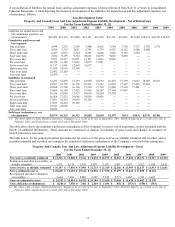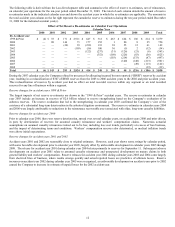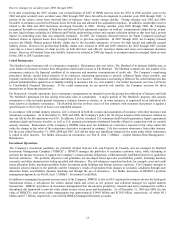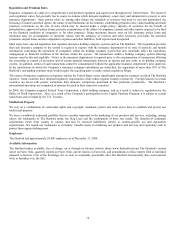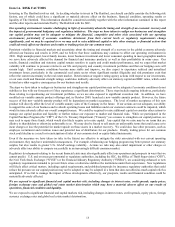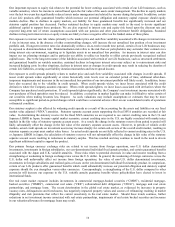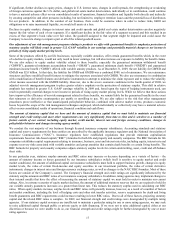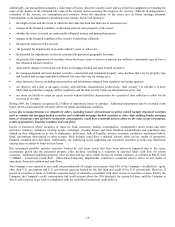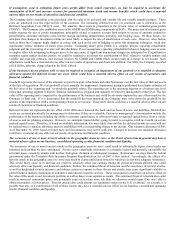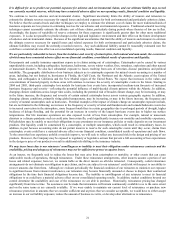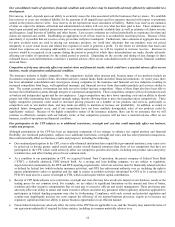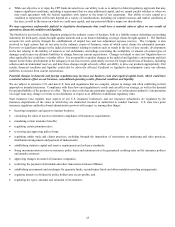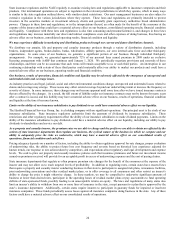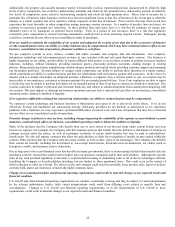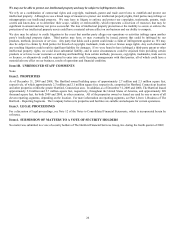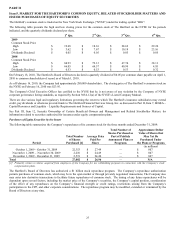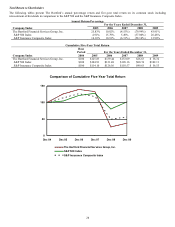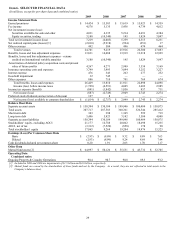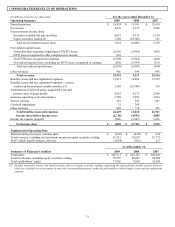The Hartford 2009 Annual Report Download - page 21
Download and view the complete annual report
Please find page 21 of the 2009 The Hartford annual report below. You can navigate through the pages in the report by either clicking on the pages listed below, or by using the keyword search tool below to find specific information within the annual report. 21
It is difficult for us to predict our potential exposure for asbestos and environmental claims, and our ultimate liability may exceed
our currently recorded reserves, which may have a material adverse effect on our operating results, financial condition and liquidity.
We continue to receive asbestos and environmental claims. Significant uncertainty limits the ability of insurers and reinsurers to
estimate the ultimate reserves necessary for unpaid losses and related expenses for both environmental and particularly asbestos claims.
We believe that the actuarial tools and other techniques we employ to estimate the ultimate cost of claims for more traditional kinds of
insurance exposure are less precise in estimating reserves for our asbestos and environmental exposures. Traditional actuarial reserving
techniques cannot reasonably estimate the ultimate cost of these claims, particularly during periods where theories of law are in flux.
Accordingly, the degree of variability of reserve estimates for these exposures is significantly greater than for other more traditional
exposures. It is also not possible to predict changes in the legal and legislative environment and their effect on the future development
of asbestos and environmental claims. Because of the significant uncertainties that limit the ability of insurers and reinsurers to estimate
the ultimate reserves necessary for unpaid losses and related expenses for both environmental and particularly asbestos claims, the
ultimate liabilities may exceed the currently recorded reserves. Any such additional liability cannot be reasonably estimated now but
could have a material adverse effect on our consolidated operating results, financial condition and liquidity.
We are particularly vulnerable to losses from the incidence and severity of catastrophes, both natural and man-made, the occurrence
of which may have a material adverse effect on our financial condition, consolidated results of operations and liquidity.
Our property and casualty insurance operations expose us to claims arising out of catastrophes. Catastrophes can be caused by various
unpredictable events, including earthquakes, hurricanes, hailstorms, severe winter weather, fires, tornadoes, explosions and other natural
or man-made disasters. We also face substantial exposure to losses resulting from acts of terrorism, disease pandemics and political
instability. The geographic distribution of our business subjects us to catastrophe exposure for natural events occurring in a number of
areas, including, but not limited to, hurricanes in Florida, the Gulf Coast, the Northeast and the Atlantic coast regions of the United
States, and earthquakes in California and the New Madrid region of the United States. We expect that increases in the values and
concentrations of insured property in these areas will continue to increase the severity of catastrophic events in the future. Starting in
2004 and 2005, third-party catastrophe loss models for hurricane loss events have incorporated medium-term forecasts of increased
hurricane frequency and severity - reflecting the potential influence of multi-decadal climate patterns within the Atlantic. In addition,
changing climate conditions across longer time scales, including the potential risk of broader climate change, may be increasing, or may
in the future increase, the frequency and severity of certain natural catastrophe losses across various geographic regions. In addition,
changing climate conditions, primarily rising global temperatures, may be increasing, or may in the future increase, the frequency and
severity of natural catastrophes such as hurricanes. Potential examples of the impact of climate change on catastrophe exposure include,
but are not limited to the following: an increase in the frequency or severity of wind and thunderstorm and tornado/hailstorm events due
to increased convection in the atmosphere, more frequent brush fires in certain geographies due to prolonged periods of drought, higher
incidence of deluge flooding, and the potential for an increase in severity of the largest hurricane events due to higher sea surface
temperatures. Our life insurance operations are also exposed to risk of loss from catastrophes. For example, natural or man-made
disasters or a disease pandemic such as could arise from avian flu, could significantly increase our mortality and morbidity experience.
Policyholders may be unable to meet their obligations to pay premiums on our insurance policies or make deposits on our investment
products. Our liquidity could be constrained by a catastrophe, or multiple catastrophes, which could result in extraordinary losses. In
addition, in part because accounting rules do not permit insurers to reserve for such catastrophic events until they occur, claims from
catastrophic events could have a material adverse effect on our financial condition, consolidated results of operations and cash flows.
To the extent that loss experience unfolds or models improve, we will seek to reflect any increased risk in the design and pricing of our
products. However, the Company may be exposed to regulatory or legislative actions that prevent a full accounting of loss expectations
in the design or price of our products or result in additional risk-shifting to the insurance industry.
We may incur losses due to our reinsurers’ unwillingness or inability to meet their obligations under reinsurance contracts and the
availability, pricing and adequacy of reinsurance may not be sufficient to protect us against losses.
As an insurer, we frequently seek to reduce the losses that may arise from catastrophes or mortality, or other events that can cause
unfavorable results of operations, through reinsurance. Under these reinsurance arrangements, other insurers assume a portion of our
losses and related expenses; however, we remain liable as the direct insurer on all risks reinsured. Consequently, ceded reinsurance
arrangements do not eliminate our obligation to pay claims, and we are subject to our reinsurers’ credit risk with respect to our ability to
recover amounts due from them. Although we evaluate periodically the financial condition of our reinsurers to minimize our exposure
to significant losses from reinsurer insolvencies, our reinsurers may become financially unsound or choose to dispute their contractual
obligations by the time their financial obligations become due. The inability or unwillingness of any reinsurer to meet its financial
obligations to us could have a material adverse effect on our consolidated operating results. In addition, market conditions beyond our
control determine the availability and cost of the reinsurance we are able to purchase. Historically, reinsurance pricing has changed
significantly from time to time. No assurances can be made that reinsurance will remain continuously available to us to the same extent
and on the same terms as are currently available. If we were unable to maintain our current level of reinsurance or purchase new
reinsurance protection in amounts that we consider sufficient and at prices that we consider acceptable, we would have to either accept
an increase in our net liability exposure, reduce the amount of business we write, or develop other alternatives to reinsurance.


